
Cranberries are a group of evergreen dwarf shrubs or trailing vines in the subgenus Oxycoccus of the genus Vaccinium. In Britain, cranberry may refer to the native species Vaccinium oxycoccos, while in North America, cranberry may refer to Vaccinium macrocarpon. Vaccinium oxycoccos is cultivated in central and northern Europe, while Vaccinium macrocarpon is cultivated throughout the northern United States, Canada and Chile. In some methods of classification, Oxycoccus is regarded as a genus in its own right. They can be found in acidic bogs throughout the cooler regions of the Northern Hemisphere.

Vaccinium is a common and widespread genus of shrubs or dwarf shrubs in the heath family (Ericaceae). The fruits of many species are eaten by humans and some are of commercial importance, including the cranberry, blueberry, bilberry (whortleberry), lingonberry (cowberry), and huckleberry. Like many other ericaceous plants, they are generally restricted to acidic soils.

Vaccinium vitis-idaea, the lingonberry, partridgeberry, mountain cranberry or cowberry, is a small evergreen shrub in the heath family Ericaceae, that bears edible fruit. It is native to boreal forest and Arctic tundra throughout the Northern Hemisphere, from Europe and Asia to North America. Lingonberries are picked in the wild and used to accompany a variety of dishes in Northern Baltoscandia, Russia, Canada and Alaska. Commercial cultivation is undertaken in the U.S. Pacific Northwest and in many other regions of the world.
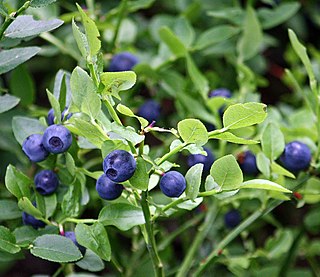
Bilberries, or sometimes European blueberries, are a primarily Eurasian species of low-growing shrubs in the genus Vaccinium, bearing edible, dark blue berries. The species most often referred to is Vaccinium myrtillus L., but there are several other closely related species.
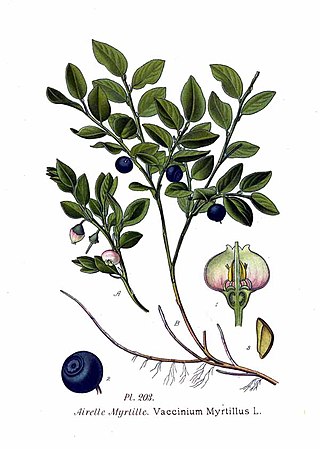
Vaccinium myrtillus or European blueberry is a holarctic species of shrub with edible fruit of blue color, known by the common names bilberry, blaeberry, wimberry, and whortleberry. It is more precisely called common bilberry or blue whortleberry to distinguish it from other Vaccinium relatives.
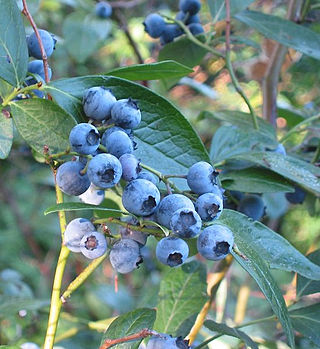
Vaccinium corymbosum, the northern highbush blueberry, is a North American species of blueberry which has become a food crop of significant economic importance. It is native to eastern Canada and the eastern and southern United States, from Ontario east to Nova Scotia and south as far as Florida and eastern Texas. It is also naturalized in other places: Europe, Japan, New Zealand, the Pacific Northwest of North America, etc. Other common names include blue huckleberry, tall huckleberry, swamp huckleberry, high blueberry, and swamp blueberry.

Vaccinium uliginosum is a Eurasian and North American flowering plant in the genus Vaccinium within the heath family.
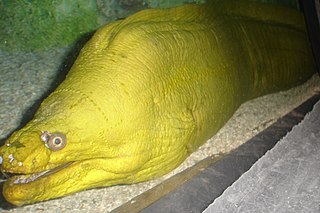
The green moray is a moray eel of the family Muraenidae, found in the western Atlantic Ocean from New Jersey, Bermuda, and the northern Gulf of Mexico to Brazil, at depths down to 40 metres (130 ft). Its length is up to 2.5 metres (8.2 ft).
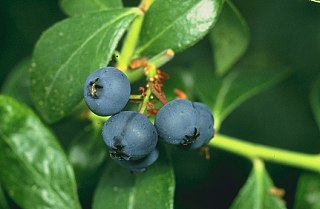
Blueberries are a widely distributed and widespread group of perennial flowering plants with blue or purple berries. They are classified in the section Cyanococcus within the genus Vaccinium. Vaccinium also includes cranberries, bilberries, huckleberries and Madeira blueberries. Commercial blueberries—both wild (lowbush) and cultivated (highbush)—are all native to North America. The highbush varieties were introduced into Europe during the 1930s.

Vaccinium ovalifolium is a plant in the heath family having three varieties, all of which grow in northerly regions, including the subarctic.
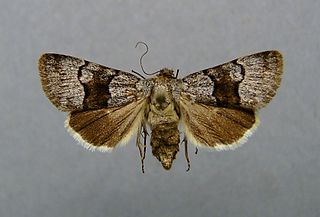
Sympistis is a genus of moths of the family Noctuidae. The genus was erected by Jacob Hübner in 1823.
Sympistis amun is a moth of the family Noctuidae first described by James T. Troubridge in 2008. It is found in western North America from southwestern Alberta to British Columbia, southward to northern California at altitudes of about 5,400 feet.
Sympistis arizonensis is a moth of the family Noctuidae first described by William Barnes in 1928. It is found in the United States in southeastern Arizona as well as northern Colorado. It was formerly known as Oncocnemis arizonensis, but was transferred to the genus Sympistis in 2008.
Sympistis nigrita is a moth of the family Noctuidae. The nominate subspecies is found in the Northern part of Europe.
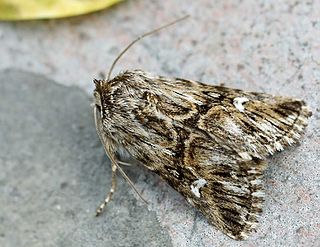
Oncocnemidinae is a subfamily of moths which belong to the large moth family (Noctuidae). In contrast to most other members of the family, they fly during the day. Oncocnemidinae are small, dark coloured moths, but the backs of their wings are generally white with broad, black stripes.

Sympistis lapponica is a moth of the family Noctuidae first described by Thunberg in 1791. It is found in Fennoscandia and northern Russia, Asia and northern North America.

Vaccinium oxycoccos is a species of flowering plant in the heath family. It is known as small cranberry, marshberry, bog cranberry, swamp cranberry, or, particularly in Britain, just cranberry. It is widespread throughout the cool temperate northern hemisphere, including northern Europe, northern Asia and northern North America.
Sympistis dentata, the toothed apharetra moth, is a moth of the family Noctuidae described by Augustus Radcliffe Grote in 1875. It is found from Yukon, the Northwest Territories, and British Columbia to Newfoundland and the northern United States, south in the east to New Jersey. It is listed as threatened in the US state of Connecticut.

Sympistis heliophila is a species of moth in the family Noctuidae. It is found in Europe and northern Asia and North America.















